Going out on a limb here… in a couple of years’ time, maybe less, the shiny digital disc might just be hip again. Like vinyl became lit a few years ago and still thrives. Mind you, while music streaming has evolved to ‘audiophile’ levels of performance, to many music lovers the CD still has the sonic edge. Of course, countless discs fill collections worldwide satisfying enthusiasts’ music experiences while reflecting the audio zeitgeist. Heck, you can even pick-up a mint previously-loved CD at a suburban market for a couple of bucks and it’ll play like new. For these reasons, and many others, a growing number of audio makers are offering CD players and disc transports with a view to meeting an underground demand. Audia Flight’s elegant FLS20 is a new disc spinner designed to handle both Red Book CD and the niche, yet persistently desirable, SACD format. Plus, the forthcoming streamer board will complete the FLS20’s digital playback suite, offering music lovers a unified digital music playback solution. So, care to go for a spin?
Flight not Fight
The FLS20 is Italian audio specialist Audia Flight’s current all-out effort to produce a modern digital source component (the company also offers a more affordable FL CD Three S CD player). To that end, the unit is capable of handling the SACD and CD formats and can accept a USB input from a music server source. My review unit was an early sample which required both a software and physical update in order to ‘tal;k’ to my music server. The fix was somewhat involved meaning that, at the time, carrying out the time consuming exercise was not viable. So, this review tackles the unit as a disc spinner and DAC via S/PDIF and AES/EBU. I’m told by Audia Flight’s Australian distributor that all future units will be completely upgraded and simply plug-and-play.
Audia Flight has also been working on a streaming module which can be optioned as an add-on. The company has been working on offering the best possible solution for this important option and I’m told development is at a very advanced stage. The feature will include a whole host of functionality, streaming service compatibility (Tidal, Qobuz, Spotify and more), music library control, wide format/file support, and more. I’m told launch should not be too far away (as of July 2025).
In light of the above, within the scope of this review I tested the FLS20 both as an SACD and CD player, via its analogue outputs into the Supratek preamplifier, as a CD transport via S/PDIF coaxial and AES/EBU connectivity into my reference Totaldac tri-unity converter, and finally as a digital-to-analogue converter via its S/PDIF coaxial input.
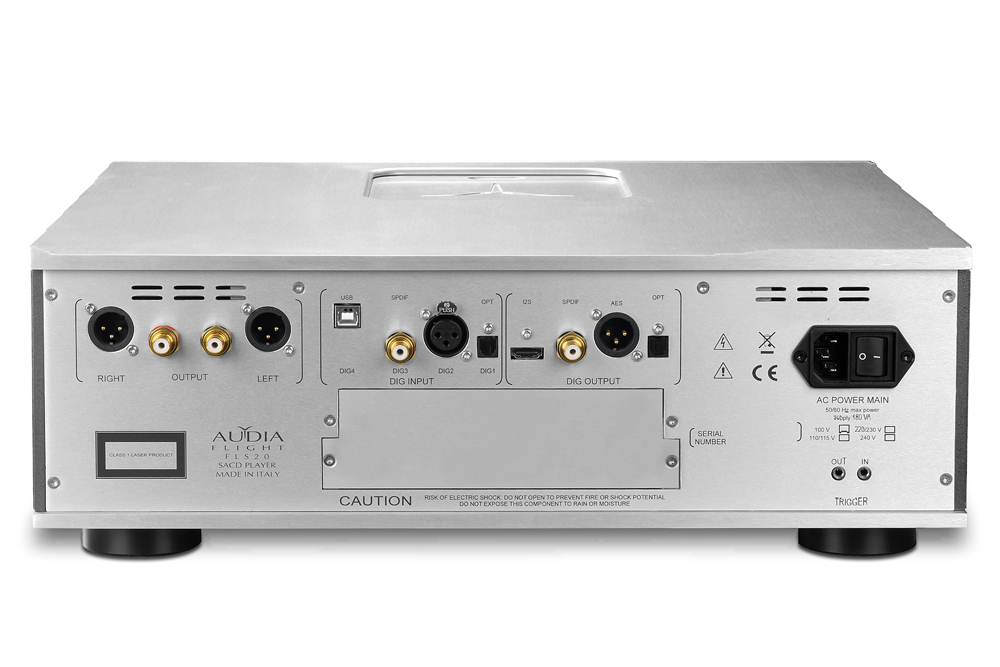
While we’re on the subject of connectors, the FLS20 features inputs for USB-B audio, S/PDIF RCA coaxial, AES/EBU via XLR, and Toslink optical. Digital outputs include HDMI for I2S, S/PDIF RCA coaxial, AES/EBU via XLR, and Toslink optical. Analogue outputs cater to both balanced XLR and unbalanced RCA. An IEC socket coupled to the on/off switch and in/out 12V triggers round out the connectivity. At this point, I should mention the efficient rear panel layout and the first-class connector quality.
Audia Flight has chosen the highly acclaimed ESS Technology ES9038PRO 32-bit conversion chips, used here in a one per channel ‘mono mode’ configuration. The DAC circuit is coupled to a high precision, ultra-low noise Crystek CCHD-950 clock. Audia Flight quotes the FLS20’s resolution capabilities via the USB input to stretch to 32-bit/384 kHz PCM and DSD512.
There are a number of in-built filter options available at the touch of a button or two. PCM filters include Fast/Slow/Apodising Roll-Off Linear Phase, Fast/Slow/Hybrid Roll-Off Minimum Phase (the default setting is Fast Roll-Off Minimum Phase) and Brick Wall. DSD offers four filter settings in the “analog domain after conversion”: Filter 1 is Roll-Off at 47.44 kHz, Filter 2 Roll-Off at 50 kHz, Filter 3 Roll-Off at 60 kHz, and Filter 4 Roll-Off at 70 kHz.
The logic circuit built within the FLS20 is quite comprehensive, with the features menu providing a wide selection of mode settings and functions. Inputs can be named, output levels set and memorised, dither activated/deactivated, PCM and DSD filters navigated, and I2S (HDMI) phase selected, in addition to many other functional adjustments.
In typical Audia Flight fashion, the design of the FLS20’s circuits and power supplies are elegantly engineered. Signal paths are kept as short as possible while the player’s circuitry has been designed to be efficient. The digital circuits are fed via 10 ultra-low noise power supplies. As per Audia Flight tradition, the FLS20’s output section is a fully balanced Class-A discrete current feedback design powered by four low noise voltage regulators featuring discrete components. The main power supply encompasses three independent toroidal transformers, with an 80VA unit for the analog stage, an 85VA transformer for the digital stage circuits and a 15VA transformer for the logic control.
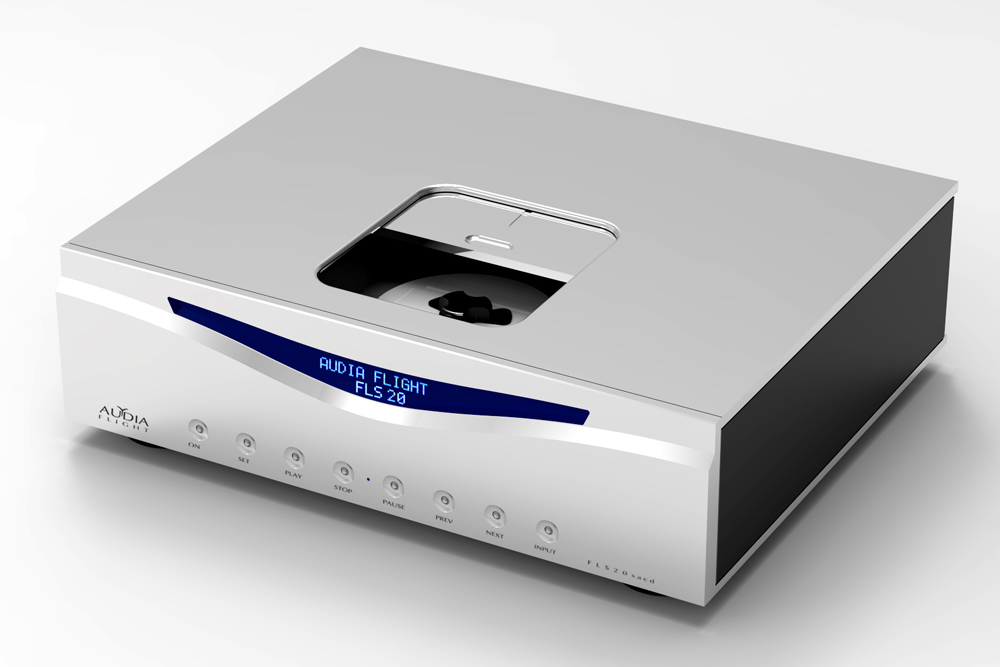
The FLS20 features a Denon top-loading disc mechanism that has been extensively modified by the Audia Flight design team. Opening the top panel’s aluminium sliding door reveals the disc transport. A disc-sized carbon fibre ‘puck’ sits atop the SACD or CD, in order to stabilise rotation. The transport is engineered to control vibrations, whether created within the chassis or externally, and is said to handle discs with “impeccable precision”.
The FLS20’s key specifications are as follows. The CD frequency response spans from 2 Hz to 20 kHz +/-0.5dB while, as you’d expect, the frequency response for SACD is elevated at the high frequencies to cover the 2 Hz to 50 kHz +/-0.5dB range. Signal-to-Noise Ratio is given as 110dB, and the Total Harmonic Distortion (THD) is 0.002% while the FLS20’s output impedance is stated as 240 ohms. The unit weighs a hefty 17kg out of the box.
The FLS20’s build quality is first-rate. All the aluminium panels are seamlessly assembled and beautifully finished while the controls operate with an assured quality. The remote control is milled from a solid piece of aluminium and is all class too, however, my only criticism is that all the buttons are identical in size, so avoiding false activations requires attentive eye-balling.
FLS20 ships in heavy gauge double boxes, is wrapped in a soft cloth and nestled with foam protectors. In order to further protect the unit, the disk mechanism is held down with a thick foam insert which sits inside the mech well. In addition, the mechanism is bolted down for shipping, so removing the four hex-head transport screws with the supplied 3 mm Allen key is mandatory and super-simple.
Laminar Flow
Across multiple Audia Flight product reviews I’ve tackled over the years, I’ve found a consistent sonic signature. Call it a house sound, if you like. I’ve found the company’s electronics (and loudspeakers, for that matter, via sister brand Alare) to expertly balance tonal complexity, midrange warmth, and excellent resolution. That’s no mean feat for solid state-based electronics. With the FLS20, the tradition continues.
It's striking how present and lifelike the midrange frequencies can sound when a system is “in song”. Given the FLS20’s accuracy feeding equally precise components down the signal chain, the sound of vocals can be quite striking. I’ve been enjoying Sally Timms’ excellent In The World of Him album where my favourite track “Corporal Chalkie” has Timms placed in a wide soundstage, her voice a convincing reproduction of a person in the room. As she describes the song’s setting, the FLS20 communicates her angst. Later in the track, as the guitar solo rages, it reflects the song’s inherent anger. The distorted cacophony cut through the track like a sonic vision, such was the extent of the instrument’s verisimilitude.
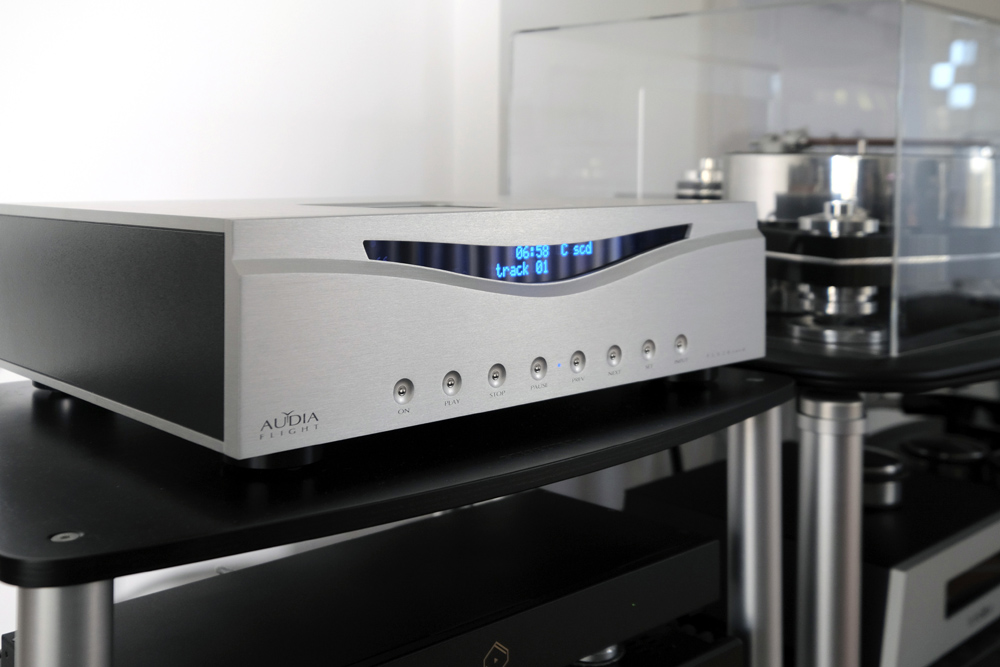
Dynamic expression through is excellent across the frequency range. For this writer, extra enjoyment comes through the midrange’s shades between low and high play with extra impact. This is often shown when voices rise, when snares cut and when guitars buzz through the mix. I got all of those things on Tool’s “Invincible” from the album Fear Inoculum where Maynard James Keenan’s often subtle and often brutal vocals, Adam Jones’ unique guitar tone, and Danny Carey’s complex drum acrobatics all weave individualised threads yet shroud coherently as a unit (filled with superb low frequency slam via Justin Chancelor’s dexterous bass lines).
Acoustic instruments were tonally precise and complex via the LFLS20. I enjoyed the differing guitar colours on LAGQ’s self-titled Los Angeles Guitar Quartet album where the shades of tone were distinct. FLS20 gave power, depth and timbrel precision to Ninad Vasilić’s acoustic bass on his superbly produced The Art Of The Balkan Bass album. In both of these examples, the FLS20’s tonal accuracy and excellent transient note response provided natural and realistic rendering of what these instruments sound like IRL.
Another strength here is spatial reproduction. Take Reference Recordings’ excellent production on Serebrier Conducts Serebrier with Uruguayan José Serebrier conducting the London Symphony Orchestra. This is a truly majestic recording which features a massive soundstage spreading in all dimensions. FLS20 handles the spaciousness with an enveloping soundfield which seemingly filled every corner of my listening studio. On “Poema Elegiaco” the thunderous crescendo and powerful percussion made me fear for the speakers (unjustifiably so… the Wilson Alexia V can take a beating). This was a truly tremendous dynamic shockwave.
In my reviews for the last couple of years or so, I continue to use the stunningly well-recorded “Tea For Two” from Tsuyoshi Yamamoto Trio’s What a Wonderful World album. The reason being that, aside from the recording’s superb sound quality, I enjoy the trio’s rendition. I also use the track’s intro as a great test of low level detail and subtle musical nuance across a wide frequency spectrum. The piano here was truly magnificent – as I hear whenever reviewing competently designed products. The FLS20 brought a sense of ease and presented outstanding levels of musical minutiae which, aside from being telling in terms of this review, it was also enjoyable on a less analytical level. As far as detail presentation combined with a non-etched, non-bright, analogue-like sound, the FLS20 can’t be faulted.
I also enjoyed the FLS20’s handling of the low frequencies. “The Real Blues” from The Ray Brown Trio’s Live At The Loa – Summer Wind album showed Brown’s dextrous handling of his instrument by reproducing its initial transient with sharp attack (especially on the tight string plucks), then blossoming the note with a solid sense of depth. The timbrel detail and resonance of the body of the acoustic bass had the right sound of ‘hollowness’ to it, making for a realistic representation of the instrument.
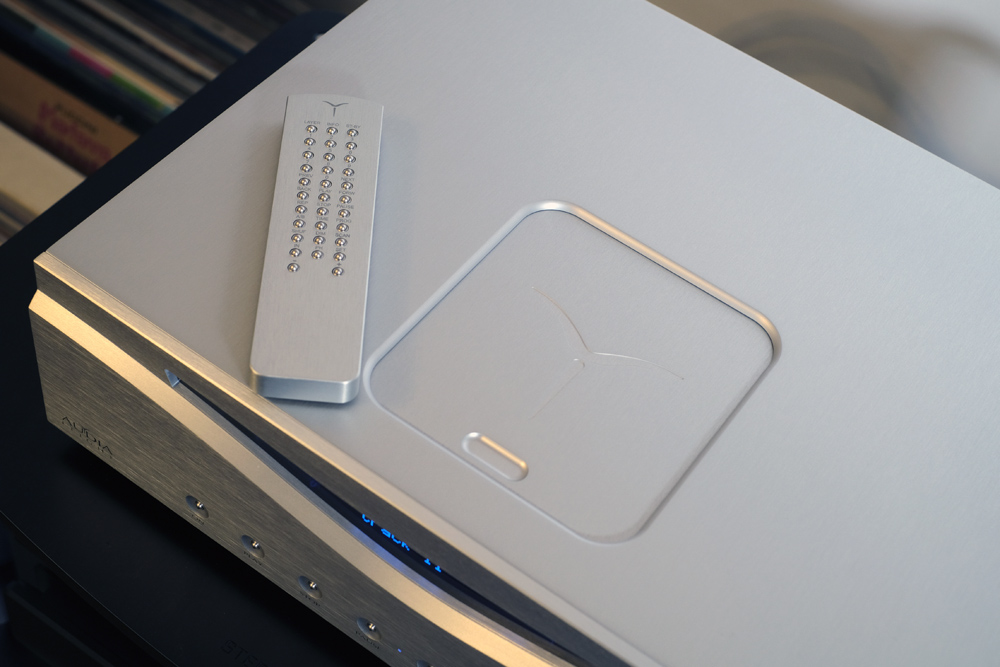
So, while the analysis above is based on the FLS20 as a SACD/CD player and DAC, the observations based on it being purely a transport via its digital outputs are less overt. While my usual transport is an upmarket Yamaha SACD/CD player in a more affordable price bracket, its disc mechanism is custom designed and built like a tank. Its solidity stems from is mostly metal construction, its super-smooth operation and an overall functionality belonging in a higher class. Were it not from a mainstream manufacturer, and if it wore a more niche branding from, say, USA or Germany, I’d wager it would fit into a price point two to three times its cost.
In addition, I’ve found differences between transports – which just carry zeros and ones across (and yes, I understand the role clock timing and related factors plays here) – range from non-existent to noticeable after careful listening. I found the FLS20 connected to my DAC played with a tad more authority and bass power when compared to my own transport. This was not overtly obvious, more a subtle difference that was, nonetheless, there.
There were recordings where I thought my transport offered a slightly more detailed rendering, but then I reverted back to the FLS20 and my findings were less… assured. What I’m asserting here is that the differences were subtle. In a blind test situation, my guess would be that most listeners may not be so confident in calling substantial variations between competent transports when their digital outputs have been designed by skilled engineers.
Conclusion
In my intro to this review, I talked about the endurance of the disc format. The FLS20 strongly bolsters that argument. It’s purpose-built for audiophiles and music lovers who treasure their vast disc libraries, particularly of the still widely available CD.
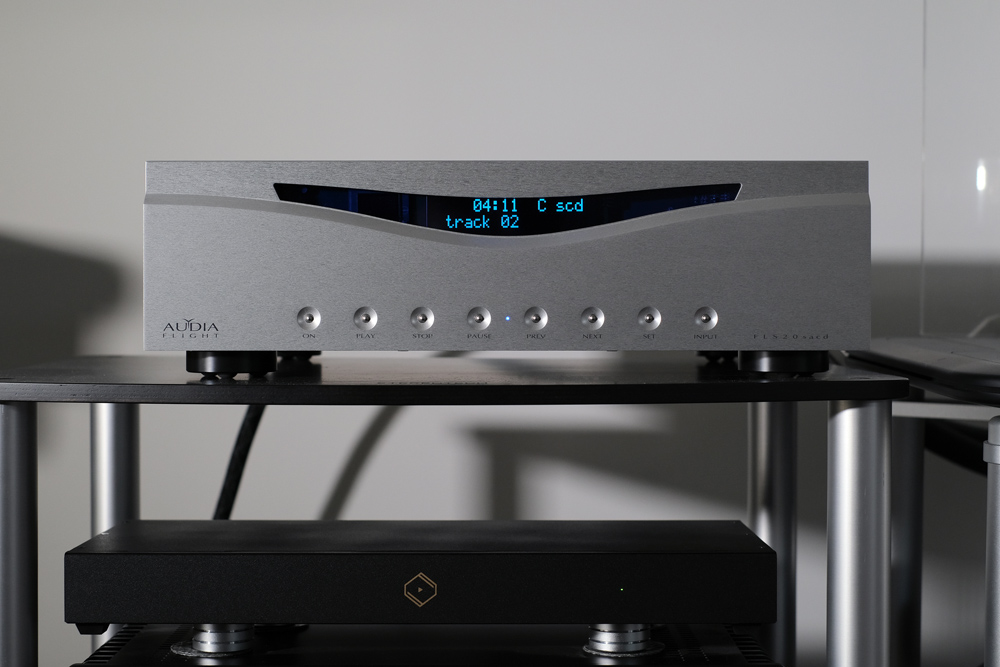
True to its intent, the FLS20 is built like a battleship on steroids and offers a whole lot of fine-tuning options via the onboard digital filters. It caters to a format that, even still, has plenty of aces up its sleeve in terms of musicality. Particularly in terms of dynamic expression, fine detail, and sonic nuance. On those markers, the SACD/CD can often even outshine high-resolution streaming.
Yes, the Audia Flight FLS20’s impressive roster of features and sonic virtues are compelling reminders of why physical disc media continues to be revered. Even coveted. And here’s me, with fingers crossed, rooting for the silver disc’s long shelf life… and hoping it will firmly secure its place well into the future of high-end audio.
… Edgar Kramer
This email address is being protected from spambots. You need JavaScript enabled to view it.
Associated Equipment
- Speakers — Wilson Audio Alexia V, Axis Loudspeakers VoiceBox S (nearfield monitor), Vermouth Audio Little Luccas Mk.II Limited Edition, Atacama stands
- Amplifier — Gryphon Audio Antileon EVO
- Preamplifier — Supratek Cortese, Totaldac d1-triunity (upgraded clock and PS) periodically, direct to amplifier
- Sources — Digital: 432 EVO Aeon Mk.3 Reference Music Server/Roon Core, Yamaha CD-S2100 transport, Totaldac d1-triunity DAC. Analogue: Transrotor Crescendo with Konstant Studio controller, Reed 1X Tonearm with upgraded internal wiring, Shelter Harmony cartridge, The Funk Firm Houdini cartridge decoupler, Supratek Cortese & REDGUM Audio RGPH2 phono stages
- Processor — DEQX PreMate (part of arsenal/casual use)
- Cables — VYDA Laboratories Orion Silver Reference HFC IC and speaker cables, PSC Audio custom design XLR, Vermouth Audio Reference loom,Tubulus Concentus USB
- Audio Rack — SGR Audio Statement MODEL V, Aspire Audio Belgravia amplifier platform (customised for Gryphon Audio Antileon EVO), Stereotech Aluminar Dark 3-tier rack
- Acoustic Treatment — Vicoustic Multifuser Wood, Wavewood Ultra, Cinema Round Premium and Super Bass Extreme
- Miscellaneous — Silent Angel Bonn N8 Pro network switch, GigaWatt PF-1 EVO power strip, Les Davis Audio Viscoelastic CLD discs, Voodoo Cable Iso-Pods, Bocchino Audio Mecado, VRC Vinyl Record Cleaning systemplus miscellaneous accessories
Audia Flight FLS 20 SACD/CD Player
Price: AU$31,990
Australian Warranty: Two Years (12 Months for Disc Drive)
Australian Distributor: Absolute Hi End
+61 488 777 999
www.absolutehiend.com
Audia Flight
Via Alfio Flores, 7
00053 Civitavecchia (RM)
+39 0766 561403
www.audia.it
